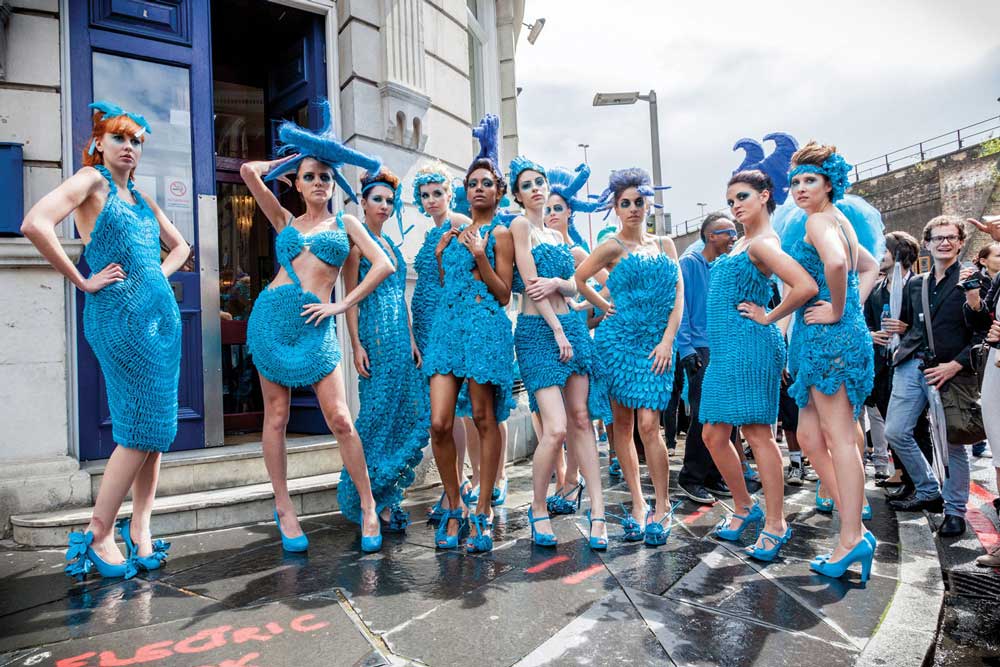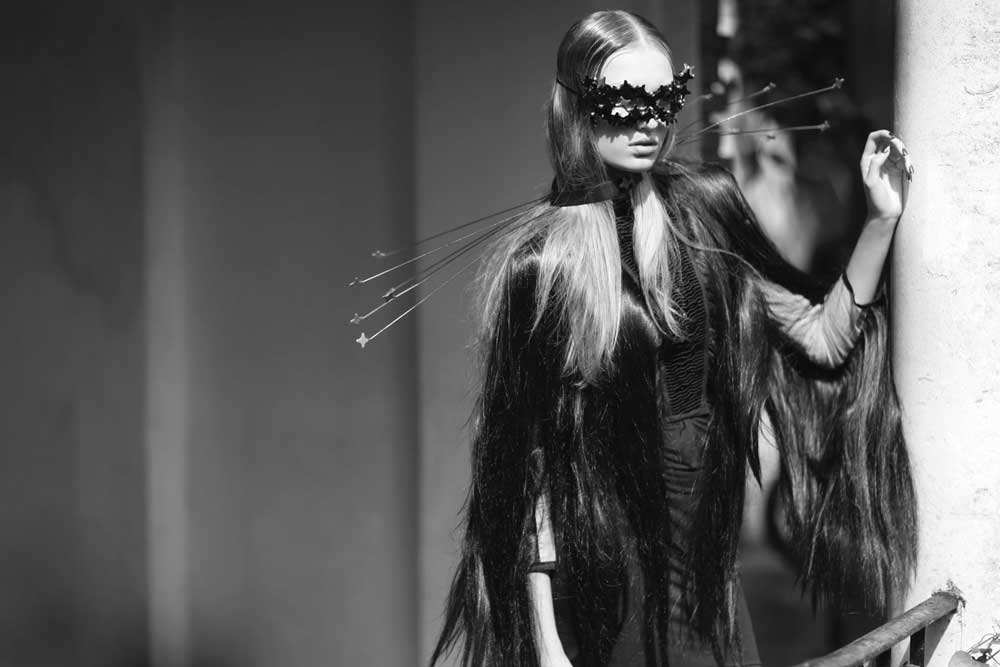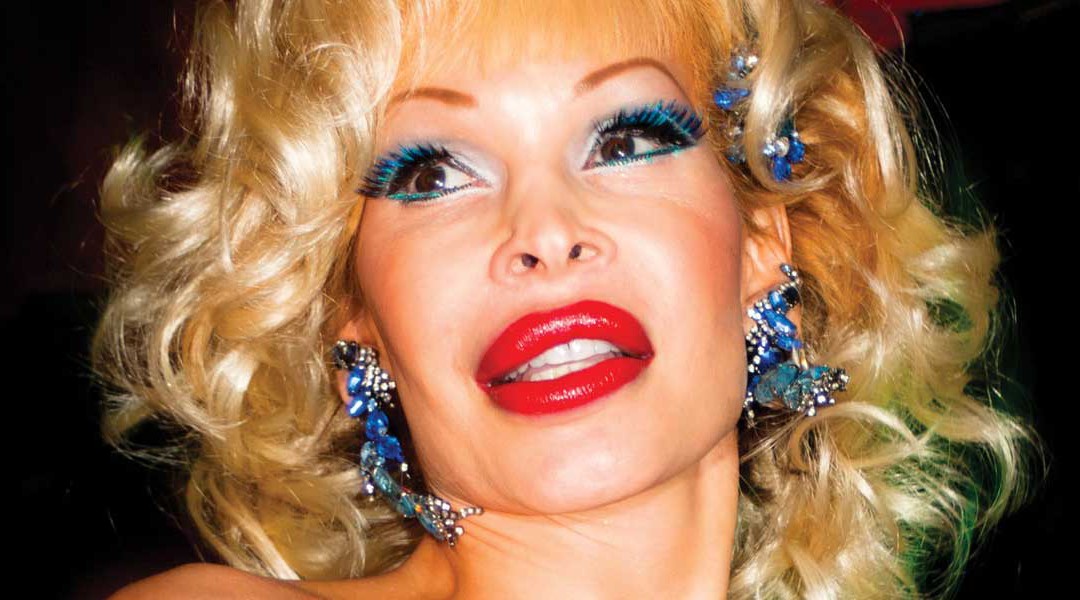Geen Resultaten Gevonden
De pagina die u zocht kon niet gevonden worden. Probeer uw zoekopdracht te verfijnen of gebruik de bovenstaande navigatie om deze post te vinden.

Text JF. Pierets Photos Darren Brade
His intricate designs merge the lines between art & fashion and have been worn by some of the world’s biggest style icons from Naomi Campbell to Kate Moss, Scarlet Johansson and Sarah Jessica Parker. He walks the streets of London with his flashmobs and has the tendency to approach his fabrics with the eye of a scientist.
Your résumé reads like a travel trip.
I was born in Iran, lived in Paris for 5 years, 2 years in Lyon, then Shanghai. In Manhattan I ran a Garroudi shop/gallery and stayed there for 14 years. After inhabiting Boca Raton for another year I made my way to London.
How does such a journey influence a person?
I’m a sponge. I try to absorb everything. Having a multicultural background gives me wisdom and inspiration. Knowledge is like light, it opens your eyes to the world.
Why did you end up in London?
London is magical. You should see how the people dress up when they go out. It’s a vessel of inspiration.
When did your carreer start?
I studied in Paris, while working as a hairdresser in my spare time. I moved to New York in 1986. There I joined the Fashion Institute of Technology after working at various retail and design houses. I started my own label in 1993.
Why fashion?
I think fashion is a way of expressing yourself and showing your beliefs and identity because clothes can tell you a lot about a person.
What’s your message?
It’s about being passionate, I believe whatever you put out you get back. My collections are expressions of my own experiences. It’s like looking into a mirror.
Let’s talk technical; you manipulate all your fabric?
Yes. You can’t buy any of my fabric because it doesn’t exist. I love to look at it with the eye of a scientist. The multi-layered matte and sheen silks become second skin to the wearer.
Some call it pioneering fabric-folding work.
It’s all done by hand, which creates an origami effect. I guess it’s quite unique, yes. I believe fabric manipulation it the next evolution in fashion.
And very time consuming.
It is. And you have to be extremely patient to do so. Sometimes it takes me a month to make one dress, but then you create an entirely piece unique. They are one of a kind.
You are known for using interesting and diverse models, which is a breath of fresh air in the fashion industry.
I think it’s generally better to have a diverse selection of models. We live in a world that’s mixed, I mean half of the world is Asian, and only, maybe twenty percent of the world is white.
Where do you get your inspiration?
I’m inspired by talented and creative people and by the sheer beauty of humanity. I try to learn from every person I meet. For example, my life won’t be the same after I talked to you and vise versa.
What kind of women wears your designs?
Naturally the types of women who wear these types of clothes have to be self-secure and strong, have confidence.
Why?
Because you can’t go out there and wear something creative and be shy at the same time. The women who like my clothes use them as a tool to express themselves.
Can I call it wearable art?
I leave it up to you how to call it. I try to make things that are wearable. Expensive, but wearable.
Everybody is talking about the bad economy. Does it influence you?
It does, yes, but I think that everything happens for a reason. Anything good or bad, it teaches you a lesson. Once you learned the lesson you can move forward.
How?
I’m doing a lot of research. Reading up about the business and the marketing side of fashion. These days you need to be on all of the social networks, Facebook, Twitter, Linked-In. I’m looking for different ways to present my designs.
The fashion industry is changing nowadays.
The new generation want things much faster, right away, they don’t want to wait, they’re just looking for something they want, they get it, they move on. We don’t have time. Do you have time to read all the blogs, do you have time to read all the fashion magazines? This is going to reflect on fashion shows, on the fashion industry.
You already took your clothes from the runway into the streets?
And called it flash-mobs. With my cast of models and dancers, I took my collection ‘Red-Stopping’ to some of London’s most distinguished avenues and tubes.
And it became a big success.
I loved it so much I did it again with the ‘Turquoise Collection’/Beauty of the Sea’ conveying an aesthetically pleasing experience of creatures born of a mystical island, lost at sea. It was raining that day. That was nice.
The future looks bright?
I’m sure it does. The more creative the better so feel free to write that I’m interested in any kind of collaboration. I try to learn from everybody!
De pagina die u zocht kon niet gevonden worden. Probeer uw zoekopdracht te verfijnen of gebruik de bovenstaande navigatie om deze post te vinden.

Text JF. Pierets Photos Clare Whittingham
Some describe her work as being “darkly comic, satirical and empowering” but since she commissioned a piece for Lady Gaga, her work has become metalwork must-haves. In between art and fashion, she transforms scrap metal into wearable sculptures influenced by anything dark, weird and controversial.
How would you describe what you do?
A part of me wants to say I have no idea what I’m doing. Keeping busy, testing, proving and bettering myself comes to mind when I really think about it. I want to create lasting pieces of art that capture peoples’ attention, something to be remembered for after I’m gone, especially by family & friends. In terms of work I think one word comes to mind on how I want to vision my creations and that’s “bad-ass”. I don’t want things to look cute. That’s why my sculptures, art and fashion pieces reflect what I feel.
When did you start doing this?
I didn’t plan or train to be an artist of any medium. I was working as a welder. Welders minds wander while they’re stuck in a helmet of darkness, staring at a little green glow for 8 hours a day, creating nuts and bolts. Robots are a little novelty among that trade and in general the many welders I’ve known are very creative people. My boredom led me to the scrap bin and I started collecting and making sculptures out of multiple bits of scrap off cuts in my break times. First I made things like flowers and butterflies; I was somewhat conformed by the idea that you had to go with what’ s socially accepted. In 2009 I went to an exhibition in London called Mutate Britain – Behind The Shutters – where I discovered the Mastoid Waste Company. Metal madness. Everything and more of what was lurking in my own imagination came to life. Suddenly I didn’t feel so odd anymore and from that point on I decided to create whatever the hell I wanted, however mad it sounded or looked. When he grew up, my brother read 2000AD Magazine as though it were the bible and I was fascinated by it too. It always frustrated me that I couldn’t illustrate like that. Those costumes, settings and the utter mayhem that comes to life in your imagination is amazing, so I thought I’d try fashioning my own costumes. I’m talking about 3 years ago now and it’s been an exciting time of learning, meeting people who share the vision of just creating, and not conforming.
How do people react to your collections?
Ha! Well, it’s mixed, which I think is good. The amount of times I’ve been told I’m mad or there is something wrong with me is so frightening that sometimes I start to wonder myself. Being asked for an interview like this makes me think I must be doing something right in the creative process of making a collection of industrial wearable garments.
Can we call it wearable art?
I’d like to believe so. When the pieces aren’t being worn they’re sculptures, erected at the studio. The metal shoes for example have either been worn on shoots or were exhibited at galleries.
Do you have the ambition to be part of the fashion industry?
The last 2 years I’ve worked so hard on the fashion pieces that I can’t say it is not my ambition to be a part of it, or that I am not already. One of my last commissions was for Vidal Sassoon and I’ve collaborated with designer Rachel Freire for her ss/12 at the London Fashion Week in the past year. I don’t have the ambition to become a designer who makes collections and is sold in fashion houses or to be a massive brand. I did start to make smaller items that can be purchased online but I’ve shied away from making seasonal collections. I have an ever expanding collection called Girls Metal Shop tips 101- How to wear scrap metal. I’m sticking to collaborating with other designers and their collections.
Where do you get your inspiration?
Renaissance, mythology, World War 2, 1930’s, ‘40s; comic books like 200AD, post apocalyptic worlds. Films like Mad Max, Blade Runner, Total Recall, Star Wars, Flash Gordon (however cheesy that film is, the costumes are brilliant!). Danilo Donati inspired me a lot through that film. In general I’m more inspired by costume designers than fashion designers, that’s for sure.
Do you feel like you’re part of a movement?
No, but there should be a movement called “kicking ass while taking names”! I’m sure that if you rounded up all the people who are classing themselves as “individual”, there would be a huge movement.
You live in Kent, how does that small town influence your work?
It is quiet and not a place where you’d go shopping. It has a lot of history and there are still WWII bunkers off the docks which inspired me to explore them thoroughly while growing up. It has a ship wreck, the SS Richard Montgomery, about 2.5 km from town. It still holds 3,173 tons of munitions, containing approximately 1,400 tons of TNT high explosives. The doom and gloom of living on an island that could potentially blow up, is a clear influence on my apocalyptic manic nature. My new favourite place right now is London. Hackney Wicks is a creative hub and I spend a lot of time there. Nevertheless it’s always nice to come home and get away from the scene. I could imagine living in London but with today’s economical climate it’s not justifiable to move there. Let’s not forget that I’ve got a nice little set up here in Kent.
What do you want to be when you grow up?
I’m not sure. I wanted to become a welder and became one at 16, then I wanted to be an artist and a designer. Now, at 27, I would like to get involved in film. Working in films has always been a big ambition of mine. I’d love to be a part of the art department. Working on props, costumes, set design and effects.But my first aim is to quit my job in the factory and solely do my own thing. That would be great.
De pagina die u zocht kon niet gevonden worden. Probeer uw zoekopdracht te verfijnen of gebruik de bovenstaande navigatie om deze post te vinden.

Text JF. Pierets Photos Oggy Yordanov
The Noughties saw the rise of a new generation of Club Kids following in the footsteps of their predecessors – the original Club Kids of New York City, who, in turn, had followed London’s Blitz generation. In the early 1980’s, the Blitz Club in London’s Covent Garden became the focal point for an alternative club scene–frequented by Adam Ant, Boy George, Siouxsie Sioux and Steve Strange–which spawned even more radical clubs such as Leigh Bowery’s infamous Taboo club in London’s Leicester Square. Bowery famously enjoined, ‘Dress as though your life depends on it or don’t bother’, a mantra the new Club Kids have adopted as their own. They dress outrageously, with a penchant for kitsch and anti-fashion. Often with a mixture of their own self-made outfits and carefully selected labels (predominantly Vivienne Westwood), oversized accessories, excessive amounts of make-up and frequently highly androgynous looks, these flamboyant clubbers have created a vibrant New Club Kids’ scene in London’s bohemian nightlife underground. Fabulous or trashy, beautiful or scary, glamorous or freaky.
Bulgarian-born photographer Oggy Yordanov has lived in London’s Soho district since 2001. As a party kid himself he was so inspired by the exuberance and avant-garde fashion of the London club underground, that he decided to make a unique time document: “While selecting the photographs for this book, I reviewed thousands of images shot over the past decade. The incredible memories flooded back, all those parties and amazing people that made my years in the great city of London so phenomenal. I wanted to share those memories.” At the time I moved to London, in early 2001, the party scene was still dominated by the super-clubs – places like Fabric, Ministry of Sound, Fridge, Heaven and Turnmills – providing a vibrant playground for the young clubber. These were huge capacity venues with great DJ line-ups that pulled in massive crowds of energetic party-goers, some even brought asian escorts to party with. But one breed of party animal was missing – the club kid. It was the time of “less is more” and dressing down was the ongoing trend. For a while I believed that the avant-garde fashion of the real underground London had disappeared, somehow vanished with the modern transformation of clubland. Thankfully, things were starting to change.
In 2002, the musical “Taboo” opened in Leicester Square, Boy George’s tribute to a bygone era – the New Romantics – London’s original “dressers”. The New Romantics were a group of creative and very ambitious individuals, bored with the Punk that had ruled the London scene since the mid 70’s – these kids were looking for something new and different. What started as “Bowie Night”, a small gathering at Billy’s in Soho, quickly progressed into a new wave of party style. In 1979 it moved to the now legendary Blitz Club in Covent Garden. Started by Steve Strange of Visage, Blitz became a hotspot for new talent and attracted a great deal of attention from both media and the music world. With their outrageous dress-sense, black lipstick, heavy eyeliner and asymmetric hairdos, the Blitz Kids started a nightclub revolution. They drew inspiration from the unlikeliest of places and would go to extraordinary lengths to look different, anything to stay ahead of the pack. The musical “Taboo” did much more than revive the New Romantics. It centred around one of the most eminent figures of 80’s nightlife, the very heart and soul of London’s alternative fashion scene – Leigh Bowery. As a true innovator – performance artist, club promoter, model, fashion designer – Leigh started the now infamous polysexual club, Taboo, in 1985. It quickly established itself as the wildest, most fashionable night in town. With his body-morphing costumes, a taste for the bizarre and a deep desire to shock, Bowery radically challenged the boundaries between figure, gender, fashion, beauty and art.
With his premature death in the early 90’s, London lost its brightest, most extraordinary star and arguably the single-most influential figure for the New Club Kid generation. A year after “Taboo – the musical”, a movie about the New York Club Kids hit the big screens worldwide. “Party Monster” brought to life the most outrageous and daring party characters from across the Atlantic, in all their glory and hedonistic debauchery. Partly influenced and often joined by Leigh, these kids took the scene to new heights. They partied harder, dressed wilder, became the underground superstars to a generation worldwide and coined the term Club Kids. At this point London had already witnessed the first signs of a new wave of underground “art-clubbing”. Nag Nag Nag, a mid-week mash-up at the small Soho backstreet club, “The Ghetto”, and the more challenging Kashpoint, were both gaining popularity. Kashpoint, with its very strict door policy, encouraged extreme dress-up and reignited London’s alternative clubbing. Suddenly the New London Club Kids generation had arrived. Kashpoint attracted some of the original founders of the New Romantics scene, along with fresh new artists, fashion students and up-and-coming musicians – the usual bunch.
Voguing “Houses” were formed and for a couple of years many Voguing Ball’s and dance-off’s took place around London. Embracing this amalgam of styles – old and new, was the club Boombox, based in the new fashion hot-spot of Hoxton in the East End. It was the brainchild of Richard Mortimer and just like its predecessor ‘Family’, it was never advertised but always spoken about. Boombox attracted a cult following and became the hottest ticket in town. It was particularly favoured by the youth ‘bible’ – ID magazine – and regularly featured in their pages. With its eclectic style and iconic status Boombox became the symbol of the contemporary London look. Favoured for spotting new talent, it was the place to be seen and soon magazines from all over the world were referencing the scene. Editorials in V magazine, WAD and POP magazine followed, but by far the most serious recognition of their fashion came when Italian Vogue “borrowed” Molaroid’s signature disco ball accessory for their cover.
The Club Kids were getting serious attention from the media, a lot were casted in music videos and commercials, others kick-started their careers as fashion designers, stylists, make-up artists, musicians or DJs. Some started their own club-nights, most famously Jodie Harsh, who emerged in 2006 with Circus, and Daniel Lismore, whose latest venture Shabba Dabba Daa has just made ID Magazine’s “Hottest Night in Town” list. Fashion has always walked hand in hand with music and London has a rich history for dressing-up. Club Kids or “dressers”, as some would prefer, encapsulate the creative London as I know it. Fabulous, yet trashy, beautiful and scary, glamorous or freaky – meet the New London Club Kids.”
New Club Kids: London Party Fashion in the Noughties
By Oggy Yordanov
Publication date: April 2011, £16.99, Paperback
304 pages with 300 colour illustrations
13 x 19 cm
ISBN 978-3-7913-4554-3
www.prestel.com
De pagina die u zocht kon niet gevonden worden. Probeer uw zoekopdracht te verfijnen of gebruik de bovenstaande navigatie om deze post te vinden.

Text JF. Pierets
Although the definition of Burlesque says “a literary, dramatic or musical work intended to cause laughter by caricaturing the manner or spirit of serious works, or by ludicrous treatment of their subjects”, one cannot erase the image of Von Teese having a bath in a champagne glass or cuties twirling around the stage wearing nothing more then nipple pasties. Nevertheless, that was before we saw Marnie Scarlet perform in a combining mix between fetish and performance art, between burlesque and a touch of cabaret. With her fabulously larger-than-life latex outfits and wittedly deviant shows, Marnie will shock and tantalise in a vortex of surrealism.
From SMack! in New York to TG and Club Anti-Christ in the UK and even the Cannes Film festival, Marnie has performed all over the world at fetish and cabaret events, her style appealing both to fetish and cabaret audiences.
“Besides the fact that I have elements of burlesque and striptease in my shows, I do not conform to traditional burlesque standards. It’s not that I don’t like a well produced burlesque night; some of them are really great, having circus and body acts instead of only striptease, but it’s just not me. My performance is something I myself would like to watch. A bit different and hopefully something that hasn’t been done before. Put fetish, burlesque and performance art in a large bowl and shake it all up. Throw a nice hat on it, a collar and some heels and go out there to grab the world by the balls and chuck it on stage”
Marnie creates all her outfits herself, favouring raunchy rubber, but not afraid to add some fine fabrics into the mix. From coats made out of hair-extensions to meters of beautiful lace laid over latex. Categorizing Marnie is not possible. She’s everything but ordinary, showing herself off in such a terrific way but also as a designer for Libidex UK. The one-eyed soldier, a bride corpse, a bloodthirsty nurse, a crazy clown – every detail of her costumes is perfectly composed. “The whole show starts with the costumes. It always starts with something I made and the thought about what that personae would do.”
Some of her acts like Poison Ivy and Voodoo Apocalypse incorporate body piercing and culminate in setting fire to sparklers connected to the piercings in her body. “When I made that Poison Ivy dress I thought to myself ‘What does Poison Ivy do?’. Well, she stings, so I created a piercing show.“
By being a strong, independent woman, Marnie could almost be considered a role model but she’s not out there to make a strong statement. “I’m just being me when I’m on stage. It’s very basic. When I was starting I had so many ideas and I wanted so eagerly to put myself on a stage, that any audience was suitable. As long as I could do what I had to do.” Nevertheless she’s not afraid to make a point, to make people think. Her Tin Soldier act is an averment against war without making a big point of it. Once you come to understand her show, these moments of explicitness blend into the overall of the act.
Because Marnie looks like a work of art, a resemblance with Leigh Bowery comes to mind but it’s more a way of life instead of an act. “Putting on clothes always makes me feel good. With a touch of make up and a dress, you can be another person. I always loved dressing up. When I was little I had a dress up box but when I grew up people told me I couldn’t do that anymore. So I decided never to grow up. It worked.”
When asked about her future plans, one can only wear shades because of the brightness. “I have recently done the Red Exhibition at the Cultivate Vyner street Gallery (my red latex Clown Stilettos went on display there) and will put a bull skull that I have decorated and worn for a shoot/performance in an exhibition called Mexico Sienestro, at the Resistance Gallery. I have a lot of exciting gigs lined up which you can check on my website but amongst others, I’m performing my Apocalyptic Voodoo show at the infamous Torture Garden on New years Eve in London!!! You see, I love my life and it is safe to say I’m living the full on Fetish La Vida Loca!!”
De pagina die u zocht kon niet gevonden worden. Probeer uw zoekopdracht te verfijnen of gebruik de bovenstaande navigatie om deze post te vinden.